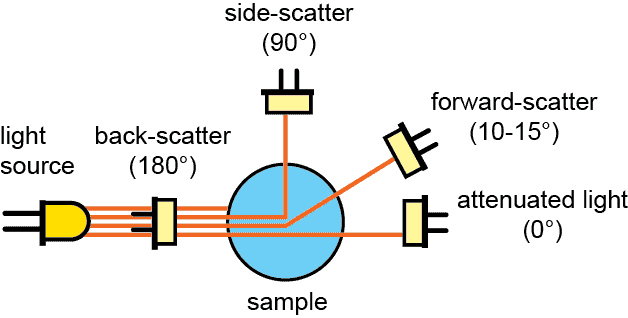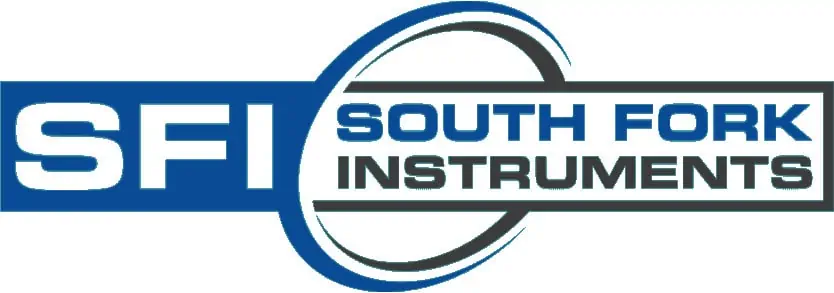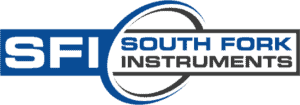The Kemtrak NBP007 measures the amount of suspended solids in a sample using backscattered light. While the use of backscattered light is typically applied to measuring suspended solids, the technique is equally applicable to emulsions, suspensions, dispersions and foams. The suspended phase may be either solids (e.g. calcium carbonate) or two immiscible liquid phases, such as oil in water or gas in a liquid (i.e. foam).
The measurement of backscattered light is also a measurement of turbidity. However, one must be aware of significant differences between backscattered light (180°) and other turbidity measurement technologies such as attenuated light measurement (light passing directly through the sample at 0°), forward-scattered light (typically 10-15°), and side-scattered light (at 90°).

Attenuated, forward, and side-scatter turbidity measurement techniques require light to enter into a sample, be scattered by particulates suspended in that sample and then emitted from the cell where the intensity of light can be measured by one or more photodetectors. As light must pass through the sample before being emitted, it is essential the optical density (i.e. concentration of particulates in the sample) is not too high or no light will be emitted. Such techniques are therefore typically used for low and very low sample concentrations or turbidities (<1% total suspended solids down to 0.0005% or 0.01-4000 FNU/NTU).
Backscatter differs in that the sample is illuminated at the window’s surface, and the light scattered back is measured. Light does not have to pass through the sample before measurement. As the concentration of the sample varies, the amount of light scattered back to the detector will vary, making this measurement technique suitable to measure just about any level of solids, even all the way up to 100%. The lower limit or measurement resolution of backscatter is typically around 0.001% suspended solids or 10 FNU/NTU. Backscattered light measurement can provide a wide dynamic range of measurement for applications where suspended solids levels can vary dramatically.
It should be noted that scattered light measurement is a function of concentration, particle size, and—to a lesser extent—refractive index and color. If you intend to measure concentration using any scattered light measurement technology, then it is essential that particle size is consistent. Samples where the refractive index of the suspended particles and continuous phase are similar will not scatter light—light will pass straight through the sample—and should be avoided (e.g. sweetened condensed milk). In the NBP007, measurement is made in the near infrared (NIR, 850nm and higher) and sample color therefore generally has no influence. However, if the sample is known to be highly colored, the influence of the color should always be checked in advance.
Applying Backscatter Measurements to Real-Life Applications
There are a plethora of applications where an accurate measurement of solids concentration is a real advantage. But measurement in many of these applications has historically been performed with instruments that do not have the dynamic range necessary for the job. A prime example is the measurement of spent yeast slurry in breweries. In large scale breweries, spent yeast is sold for animal feed, providing a revenue stream for the brewery while disposing of a large amount of biomass—a win-win for both the brewery and the processor taking the spent yeast.
However, there is a cost associated with transporting spent yeast in trucks, so it is important that the concentration of yeast in the slurry is high enough for the economics to work out. On the other side, too high a concentration can cause pumping and pipe transport difficulties. A reasonable target for solids concentration is around 50%.
A well-known brewery had implemented spent yeast solids concentration measurement using attenuated light probes. These probes, reading in an arbitrary CU unit, worked to some degree at low levels of solids concentration, but exhibited a nonlinear response to higher levels and quickly became blinded over 20% solids. Furthermore, when they were reading, they exhibited continuous drift. This resulted in several batches of spent yeast leaving the brewery with low solids concentration, and charge backs from the processor. Technicians in the plant tried to remedy the issue and operators attempted to work within the limitations of the system. But eventually, the measurements were abandoned, and the operators reverted to manual measurements when transferring spent yeast.
A Kemtrak NBP007 12mm OD backscatter probe was installed in the same Tuchenhagen VariVent “ball” as the transmission probe using an Exner EXstatic port adapter to improve the measurement and resolve the back charge issues the plant was experiencing. Using the native BU (backscatter unit) readout, the NBP007 provided a linear response to solids concentration changes across the entire range with no baseline drift. The unit was then correlated to actual solids concentration and set up in the DCS system as a live solids concentration measurement. Several years later, it continues to provide accurate and reliable readings of solids concentration, and is used to prompt the addition or removal of water from the spent yeast slurry circulating in the spent yeast loop. Savings to the brewery are estimated to be in the hundreds of thousands of dollars over the time it has been in operation, compared to the costs associated with the previous methods, and additional NBP007s have been installed in the plant where high solids levels are experienced.
A unique benefit of the Kemtrak backscatter (or reflectance) probes is that they will not go blind at any concentration of suspended solids. The output of the Kemtrak NBP007 will continue to increase with sample concentration, ensuring a reliable measurement at any concentration. The NBP007-L (low range) analyzer is recommended for process concentrations up to 10% total solids, while the NBP007-H (high range) analyzer should be used for accurate monitoring of suspended solids exceeding 10%.

